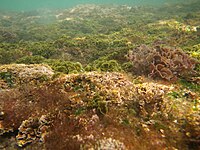Algae

Algae are tiny living things that can be found in water, on rocks, trees and pretty much anywhere that is moist. They are like plants but unlike plants, they don't have leaves, roots or flowers.
Algae come in many shapes, sizes, and colors. Some are so small that you need a microscope to see them, while others can grow as large as seaweed. They can be green, yellow, brown, red, or even blue.
Algae are very important to us because they produce oxygen through photosynthesis, like trees do. They also form the base of the food chain in aquatic ecosystems, which means that many other living things rely on them as a primary source of food.
Researchers and scientists have been studying algae for years because they can also be used to make biofuels, which can be used to power cars and other machinery. They are also used in many other products like food, cosmetics, and even medicine.
However, while algae can be very useful to us, they can also cause harm in certain situations. Sometimes, they grow too quickly and form what is called an "algal bloom" which can be harmful to the environment and human health. Some types of algae produce toxins that can make people sick if they drink or swim in water that is contaminated with them.
Overall, algae are small but mighty living things that are very important to our world.
Algae come in many shapes, sizes, and colors. Some are so small that you need a microscope to see them, while others can grow as large as seaweed. They can be green, yellow, brown, red, or even blue.
Algae are very important to us because they produce oxygen through photosynthesis, like trees do. They also form the base of the food chain in aquatic ecosystems, which means that many other living things rely on them as a primary source of food.
Researchers and scientists have been studying algae for years because they can also be used to make biofuels, which can be used to power cars and other machinery. They are also used in many other products like food, cosmetics, and even medicine.
However, while algae can be very useful to us, they can also cause harm in certain situations. Sometimes, they grow too quickly and form what is called an "algal bloom" which can be harmful to the environment and human health. Some types of algae produce toxins that can make people sick if they drink or swim in water that is contaminated with them.
Overall, algae are small but mighty living things that are very important to our world.
Related topics others have asked about:
